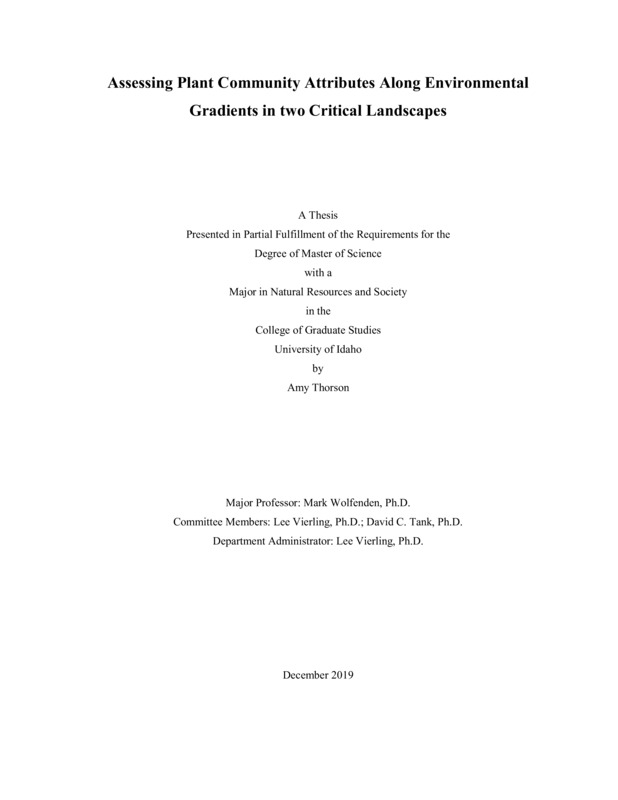Assessing Plant Community Attributes Along Environmental Gradients in two Critical Landscapes
Thorson, Amy Louise. (2019-12). Assessing Plant Community Attributes Along Environmental Gradients in two Critical Landscapes. Theses and Dissertations Collection, University of Idaho Library Digital Collections. https://www.lib.uidaho.edu/digital/etd/items/thorson_idaho_0089n_11708.html
- Title:
- Assessing Plant Community Attributes Along Environmental Gradients in two Critical Landscapes
- Author:
- Thorson, Amy Louise
- Date:
- 2019-12
- Program:
- Natural Resources
- Subject Category:
- Ecology
- Abstract:
-
"The wilderness and the idea of wilderness is one of the permanent homes of the human spirit”
Joseph Krutch (1995)
"Wilderness itself is the basis of all our civilization. I wonder if we have enough reverence for life to concede to wilderness the right to live on?"
Margaret Murie
Human activities contributing to the accumulation of greenhouse gasses in the atmosphere have created a rapid spike in surface temperatures leading to major shifts in ecological processes (Walther et al., 2002). Changes to abiotic cycles are affecting biological communities however, not all species will respond the same way. Changes to colonization and extinction rates are leading to novel communities and functional compositions, further altering ecosystem processes. (Díaz, S., & Cabido, M., 1997). Our current state of urgency regarding climate change mitigation demands a better understanding of ecosystem responses.
Relative to other landscapes, wilderness areas offer a rare opportunity to study ecological processes in a setting affected little by direct human manipulation. Studying naturally functioning systems provides a frame of reference for addressing baseline ecosystem health and can inform better management decisions (Sharman, Landres, & Boudreau, 2007). Protected under the wilderness act, wilderness areas also provide the opportunity for long-term landscape-level studies (Six et al.,2000).
Wilderness areas are critical landscapes not only as the last living laboratories to study natural ecological processes but, as a necessity to the human spirit. Research shows that more life-sustaining, intrinsic, future, and spiritual values are associated with wilderness areas than outside of these areas (Cordell et.al., 1998; Cordell, Bergstrom & Bowker, 2005). Based on a survey of 5,000 Americans by Cordell, Torrant and Greene (2003), the level of importance placed on wilderness values has increased in the 21st century compared to a 1995 survey. Beyond engaging in research on natural systems, we have a responsibility to protect our remaining wilderness areas.
The first two studies of this thesis take place in the heart of the Frank Church- River of No Return (RNR) Wilderness at one of the most remote research stations in the country. Taylor Wilderness Research Station was first established as a homestead by Dave Lewis in 1879 (Dave Lewis Papers). Prior to that, the area was a piece of the homeland inhabited by the Tukudeka (Frey & McCarl, 2014). Overtime, the rugged mountainous terrain, carved out by swift rivers, under a semi-arid climatic regime has shaped both social and ecological attributes of the communities existing within this landscape. A baseline study of plant community dynamics was conducted from the Taylor Ranch Wilderness Research station at an elevation of 3,800 ft to the summit of Dave Lewis Peak at 9,200 ft. This study aims to provide a snapshot of the current state of vegetation communities to help better understand how this biologically and culturally rich landscape will adapt and transform in our changing climate.
The third study takes place in a remote valley on the island of Kauai, HI under preservation by the National Tropical Botanic Gardens. This landscape is critical due to its conservation of rare, threatened and, culturally significant plant species in addition to its reputation as the longest remaining biocultural unit managed under the traditional Hawaiian system of land management. After a severe rainstorm event in April of 2018, flooding and landslides devasted the valley and isolated the community of Ha’ena. During this unique time in history, I had the opportunity to observe the social and ecological community dynamics after a major disturbance driven by climate change.
Together, these chapters comprise an exploration of community dynamics from a social and ecological perspective in the midst of climate change. In the first chapter, we analyze plant community characteristics in addition to phylogenetic and functional diversity patterns along an elevation gradient in a remote wilderness setting. The second chapter adds to this baseline study an investigation of floral scent composition from Penstemon species, an endemic North American taxon. In the final chapter, plant community composition and functional diversity during early succession are compared to intact communities after a recent landslide within a highly manipulated system. Woven into these chapters are aspects of my personal experiences, observations of cultural dynamics and historical accounts. With these underlying notes of human interactions with the natural world, the aim of this thesis is to explore plant community dynamics in critical landscapes from a perspective recognizing that changing landscapes will shift both social and ecological aspects of communities. The overarching goals of this project include: 1. To continue to understand these critical landscapes by collecting baseline data in order to be better stewards of the land. 2. Expose some of the cultural ties to these landscapes which are equally important with ecological aspects when considering conservation strategies.
- Description:
- masters, M.S., Natural Resources -- University of Idaho - College of Graduate Studies, 2019-12
- Major Professor:
- Wolfenden, Mark
- Committee:
- Vierling, Lee ; Tank, David C
- Defense Date:
- 2019-12
- Identifier:
- Thorson_idaho_0089N_11708
- Type:
- Text
- Format Original:
- Format:
- application/pdf
- Rights:
- In Copyright - Educational Use Permitted. For more information, please contact University of Idaho Library Special Collections and Archives Department at libspec@uidaho.edu.
- Standardized Rights:
- http://rightsstatements.org/vocab/InC-EDU/1.0/

